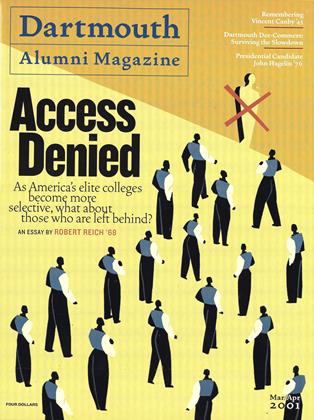QUOTE/UNQUOTE "The campus is now at a point where it's growing to the edges and filling the middle." CAMPOS PLANNER LO-YI CHAN '54
This winter the College rolled out the third update of the campus master plan first approved by trustees in 1983 and last revised just three years ago. Key components of the update include a new dining hall on the grounds of the former Dartmouth-Hitchcock Medical Center (DHMC) and 600 more dormitory beds.
"The main thing that has happened in the last two years is the student life initiative (SLI)," explains Lo-Yi Chan '54, the Colleges campus planner. "That's why the whole plan has to be revamped." In early 1999, just months after the second master plan revision was completed, the trustees kicked off a major initiative to improve residential facilities. "In a way the 1998 revision was really a prelude to what we're doing now," Chan explains.
The architect says that the two updates should be seen as different stages of the same project, with the 1998 plan identifying sites with development potential and the new update determining which buildings will go where. The 1998 master plan introduced two major projects: a math building and a life sciences building. Both will still move forward. In fact, architects will be selected this spring for the new math building, named Kemeny Hall, which is planned for a site near Berry Library. Ground will be broken in the summer.
Since trustees want to add 600 undergraduate beds in the next five years, student housing is the most ambitious component of the latest plan. It calls for a 300-to 350-bed residence hall to be constructed at the former DHMC site, and a 190-to 260-bed dormitory next to Butterfield Hall on Tuck Mall. Combined costs for both buildings are estimated in the $55-million range, according to associate provost Margaret Dyer Chamberlain.
More dorm rooms won't mean an increase in the number of students attending Dartmouth, say College officials, as undergraduate enrollment is capped at 4,400. Then why add more rooms? The need stems from Dartmouth's decision to become coeducational almost three decades ago. When women joined the student body in 1972, Dartmouth faced a thorny problem: How could the College accept more students without building more dormitories? Changing to a year-round schedule provided some relief, but over time the increasing number of students electing to be "on" during fall term caused a housing crunch. That led to the College putting two students in rooms designed as singles. "They used the god-awful term 'compression,' as if students could be compressed," says Chan. As a result, many of Dartmouth's dorm rooms are too cramped for today's students.
Trustees also hope the new dorms will draw students now living in town back to campus. About 15 percent of undergraduates currently live in off-campus housing, causing some town-gown strife while chipping away at Dartmouth's social cohesion.
And with more students living on campus, there will more mouths to feed. To that end, a dining hall costing in the neighborhood of $9 million is on the drawing board for another portion of the land once occupied by the old medical center. Chan has also drafted long-term plans for expanding graduate student apartments, consolidating the far-flung computer science department and constructing new arts and humanities buildings. Parking will become tighter than ever since the new buildings will replace parking lots. Chan predicts the College will build at least one parking garage on the outer perimeter of campus.
The new plan includes other possible projects. The local school board is considering moving the Hanover high school and middle school from their current location across from Memorial Field. If so, Dartmouth would bid for that property. The College is also talking to Hanover officials about taking possession of the town's overcrowded public library in a land swap. If that happens, Dartmouth might convert the library into residences for graduate students or faculty, according to Chan.
Dartmouth's purchase last August of a block of 19 properties in downtown Hanover was not a factor in revisiting the master plan, according to Chan, as it is not zoned for institutional use. The College made the purchase so it could determine the future of downtown Hanover. "If it was up for sale in individual parcels, we wouldn't have bought it," Chan says, "but all together it's too big a parcel to fall into someone else's hands."
Master Plan The updated campusplan establishes sites for two newdorms and a dining hall.
COLLEGE PRESIDENT PAY BENEFITS PennJudith Rodin $603,165 $52,392 ColumbiaGeorge Rupp $472,750 $27,454 PrincetonHarold Shapiro $413,000 $43,170 YaleRichard Levin $391,250 $134,437 HarvardNeil Rudenstine $315,000 $27,599 DartmouthJames Wright $306,680 $56,852 BrownE. Gordan Gee $305,290 $30,526 CornellHunter Rawlings $204,670 $220,760 Source: The Chronicle of Higher Education
Presidential Pay Here's how President James Wright's pay stub compared to those of other Ivy presidents in the 1998-1999 fiscal year.
 View Full Issue
View Full Issue
More From This Issue
-
 Cover Story
Cover StoryThe Opportunity Divide
March | April 2001 By ROBERT REICH ’68 -
 Feature
FeatureRisky Business
March | April 2001 By JAMIE HELLER ’89 -
 Feature
FeatureThe Chemistry of Crime
March | April 2001 By CHRISTOPHER KELLY ’96 -
 Personal History
Personal HistoryA Critical Relationship
March | April 2001 By Christopher Kelly ’96 -
 Article
ArticleSeen & Heard
March | April 2001 -
 Interview
Interview"I Was Made For This"
March | April 2001 By Henry Homeyer '68








